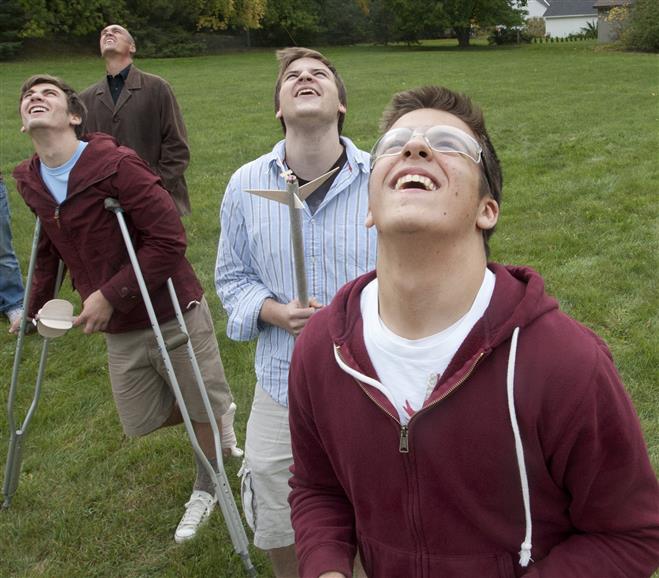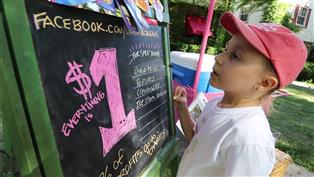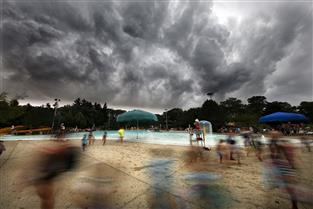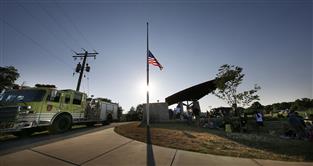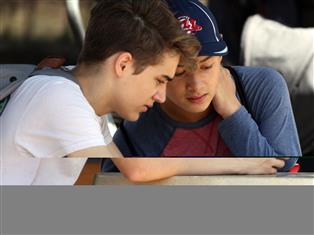Rocket launch tests designs
New engineering class off to big start
All systems are go for Wauwatosa high school students in the newly formed aerospace engineering class.
This is the first year for the class, which derives its curriculum from the science- and math-based Project Lead the Way.
The first project, a rocket launch, took place Friday. The rockets were designed by students using NASA software, tested with trigonometry and made with cardboard and balsa wood.
Students had about five days to design and build their rockets, and they calculated how high the rockets would fly. The students then juxtaposed their calculations with the results of the flight.
"We learned what makes a rocket fly," Khaled Salem, a Wauwatosa West High School student, said. "We learned all the basic principles and different formulas so we can calculate how far our rocket will go up based on the fins, the drag, lift and the weight. We spent some time designing it, and we can have a little fun while we're doing it."
Many of the rockets flew higher than 300 feet, with some failing at the launch pad and others reaching heights of more than 600 feet.
Teacher Todd DeZeeuw said: "It was a little crazy at first, but we got into a routine and I think we got all the data we needed to. The kids were paying attention, from what I saw, and I think they had a good time."
More projects coming up
The rockets are one of many group projects slated for the class.
The next project is to use software to design a glider. The students will then launch the gliders from a slingshot in the gym. DeZeeuw said he expects the launch in two weeks.
After the gliders, students will build robots. The robots will have four wheels and a robotic arm and camera. Students will use the camera to guide the robot through a test-course.
The students also will create a simulated satellite, which will drive on a track and use an ultrasonic sensor to map artificial terrain. The students will import the data from the satellite to create a digital map of the terrain.
The final unit is alternate applications, the career-component of the class. Students will write a report on any potential career plans they have.
Plans still evolving
There are also plans in the works with the Wisconsin Soaring Society to take students on an introductory sail plane flight. The students would have to pay, and the program would be optional.
Another plan on the table is to work with the Experimental Aircraft Association's Young Eagles program to arrange flights with students.
"There are some people around here who are more than willing to work with the kids," DeZeeuw said. "The sail plane instructor that I've been talking with wants to do a presentation for the class."
The class curriculum comes from Project Lead the Way, a STEM (science, technology, engineering and mathematics) program.
PLTW is a nonprofit organization that began in 1997 and now has projects in more than 47,000 middle and high schools. PLTW offers its curriculum free of charge.
"This class is fun. Most classes, you don't have the opportunity to do group activities and get out and launch rockets and stuff, and learn about space. I think it's an interesting topic. This class is more hands-on, it's not just writing in your notebook and taking notes all the time," Salem said.
More from News and Features
- Anodyne Coffee plans to open location in Wauwatosa Village
- Wauwatosa Meetings: Aug. 4
- Video: Wauwatosa girl's curbside ice cream stand raises money for the hungry
- Wauwatosa News and Notes: Hands-only CPR training offered; Firefly Art Fair is Aug. 6-7
- Wauwatosa Ask Now: Why are there barriers and fencing along the North Avenue bridges over the Menomonee River?
- Mystery Photo Contest: July 28
- Wauwatosa gears up for National Night Out event, this year at the zoo
- Election 2016: Wisconsin's 4th District candidates weigh in
- Wauwatosa's Luther Manor residents share smiles through flower delivery
- Wauwatosa Police Report: July 17-23





